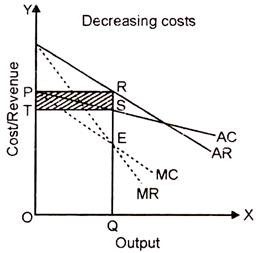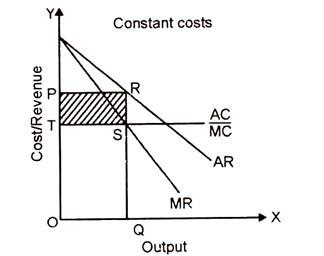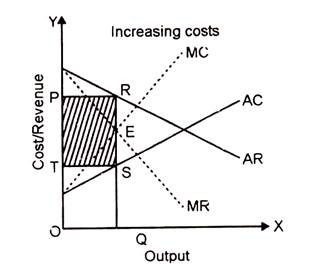The following points highlight the top three types of costs in which monopolist will earn profits. The types of costs: 1. Decreasing Costs 2. Constant Costs 3. Increasing Costs.
Type of Cost # 1. Decreasing Costs:
If an industry is operating under decreasing costs or increasing return it is advantageous to increase production and not restrict it subject of course to demand.
This is because that average cost per unit of output declines with the every increase in the output. If providentially the demand is also highly price elastic it will be advantageous to keep the price as low as possible and fulfill the increased demand.
In this diagram AC and MC are both declining with the increase in output. MC and MR are equal at point E and accordingly OQ output is determined. The average revenue and average cost are RQ and SQ respectively. RS (= RQ – SQ) is the per unit profit. If we multiply per unit profit with the total output produced, we get the total profit as PTSR = (RS x OQ).
Type of Cost # 2. Constant Costs:
The law of constant costs is also known as law of constant return. In this case the per unit cost is equal to the additional cost of production. The average cost curve and marginal cost curve are parallel to X-axis. The output is determined at point S where MC = MR. OP is the average price per unit and TO is the average cost. Thus, PT = (OP – OT) is per unit profit and PTSR in the total profits earned of the Monopolist at constant cost of production.
Type of Cost # 3. Increasing Costs:
When the laws of increasing cost or diminishing returns are in operation it is advantageous to keep the output at a low level. This is because the marginal cost as well as average costs shows a rising trend with the every increase in the output. If fortunately the demand is also inelastic, it will be advantageous to keep the price as high as possible since it is not going to reduce the demand.
In case the demand for the product is elastic the decision on price and level of output would depend on the relative strength of two forces. The output OQ is determined at point E where MC = MR and accordingly OP is the average revenue and OT is the average cost. Thus PT = OP – OT is per unit profit and PTSR in the total profits.
Thus, we find the monopolist will earn abnormal profits in all types of costs and returns.


